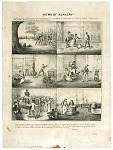unknown
Description
Between the late 1600s and the Civil War, the rapid growth of the southern plantation economy and a sparse white population led to increasing reliance on the labor of enslaved blacks. Most were agricultural laborers, but a significant number were craftspeople. Among these skilled slaves were a small number of potters working in the Edgefield District of South Carolina. Anecdotal and archeological evidence has been used to establish that enslaved potters were making face vessels in the Edgefield area before the Civil War.The origins of the southern face vessel tradition are largely un-documented. Some enslaved black potters in South Carolina certainly began making face vessels in the mid 1800s, possibly inspired by African burial rituals or as charms used in religious ceremonies. The contrasting eyes and teeth on most of the slave-made face vessels are kaolin clay, a key ingredient in the manufacture of porcelain. The Edgefield area of South Carolina was known in the 1700s and 1800s for its rich supply of kaolin.A number of face vessels have been linked stylistically to enslaved potters at Thomas Davies’ Palmetto Firebrick Works, which operated in the mid-1860s, and Lewis Miles’s Stoney Bluff and Miles Mill potteries operating from about 1837-1894. As late as 1900, ceramics historian Edwin A. Barber felt it was necessary to state that face vessels similar to these were not made in Africa, as was supposed by some collectors, but by enslaved blacks at Edgefield potteries.This piece, on the left, may have been at Lewis Miles’s pottery and...
Ceramic, Stoneware, Coarse (Overall Material)
The Estate of Mary Elizabeth Sinnott
















